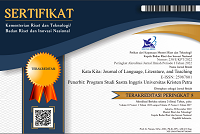CODES USED BY TWO PAIRS OF IDENTICAL TWINS
DOI:
https://doi.org/10.9744/katakita.2.2.76-81Keywords:
Design, Interior, RestaurantAbstract
This study is about the codes used by two pairs of identical twins to their co-twin in their daily conversation. It is supported by Wardaugh’s (2006) and Stromswold’s theories (2004) of codes and language development. The data was gathered from the utterances produced in the given role plays. The findings reveal that seven types of codes were used by these pairs of twins. The similarities are all of them did not use secret language and both pairs mostly used Indonesian codes. The differences are the frequency of each code used and in general, Pair 2 is more formal than Pair 1. In conclusion, having Javanese parents does not always mean using Javanese codes when communicating with others and although they are twins, they do not always use similar codes. These differences might happen because of the differences in religion and travel experiencesReferences
Holmes, J. (1985). An introduction to Sociolinguistics. London:Longman.
Piontelli, A. (2002). Twins: From Fetus to Child. USA: Routledge.
Sneddon, J. N. (2006). Colloquial Jakartan Indonesian. Australia: Pacific Linguistics.
Stromswold, K. (2004). Why aren’t identical twins linguistically identical. New Brunswick: Rutgers University. Retrieved December 1, 2012 from http://www.summer10.isc.uqam.ca/page/docs/readings/stromswold_karin/image01.pdf.
Wardhaugh, R. (2006). An Introduction to Sociolinguistic. Massachusetts: Blackwell Published.
Downloads
Issue
Section
License
Authors who publish with this journal agree to the following terms:- Authors retain copyright and grant the journal right of first publication with the work simultaneously licensed under a Creative Commons Attribution License that allows others to share the work with an acknowledgement of the work's authorship and initial publication in this journal.
- Authors are able to enter into separate, additional contractual arrangements for the non-exclusive distribution of the journal's published version of the work (e.g., post it to an institutional repository or publish it in a book), with an acknowledgement of its initial publication in this journal.
- Authors are permitted and encouraged to post their work online (e.g., in institutional repositories or on their website) prior to and during the submission process, as it can lead to productive exchanges, as well as earlier and greater citation of published work (See The Effect of Open Access).














